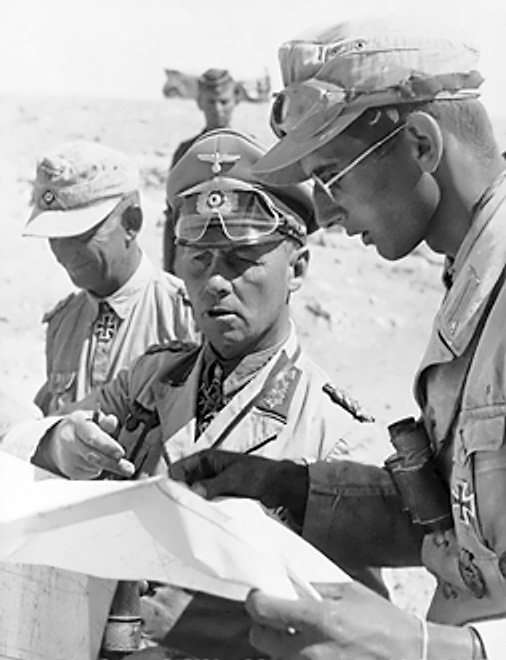|
Battle Of Gazala
The Battle of Gazala (near the village of ) was fought during the Western Desert Campaign of the Second World War, west of the port of Tobruk in Libya, from 26 May to 21 June 1942. Axis troops of the ( Erwin Rommel) consisting of German and Italian units fought the British Eighth Army (General Sir Claude Auchinleck, also Commander-in-Chief Middle East) composed mainly of British Commonwealth, Indian and Free French troops. The Axis troops made a decoy attack in the north as the main attack moved round the southern flank of the Gazala position. Unexpected resistance at the south end of the line around the Bir Hakeim box by the Free French garrison, left with a long and vulnerable supply route around the Gazala Line. Rommel retired to a defensive position backing onto Allied minefields (the Cauldron), forming a base in the midst of the British defences. Italian engineers lifted mines from the west side of the minefields to create a supply route through to the Axis side. Ope ... [...More Info...] [...Related Items...] OR: [Wikipedia] [Google] [Baidu] |
Generaloberst
A ("colonel general") was the second-highest general officer rank in the German ''Reichswehr'' and ''Wehrmacht'', the Austro-Hungarian Common Army, the East Germany, East German National People's Army and in their respective police services. The rank was equal to a four-star full general but below a general field marshal. The rank was equivalent to a ''Generaladmiral'' in the ''Kriegsmarine'' until 1945 or to a ''Flottenadmiral'' in the ''Volksmarine'' until 1990. It was the highest ordinary military rank and the highest military rank awarded in peacetime; the higher rank of general field marshal was awarded only in wartime by the head of state. In general, a ''Generaloberst'' had the same privileges as a general field marshal. A literal translation of ''Generaloberst'' would be "uppermost general", but it is often translated as "colonel-general" by analogy to ''Oberst'', "colonel", such as in countries in which the rank was adopted like Russia (, ''general-polkovnik''). "Ober ... [...More Info...] [...Related Items...] OR: [Wikipedia] [Google] [Baidu] |
Cyrenaica
Cyrenaica ( ) or Kyrenaika ( ar, برقة, Barqah, grc-koi, Κυρηναϊκή ��παρχίαKurēnaïkḗ parkhíā}, after the city of Cyrene), is the eastern region of Libya. Cyrenaica includes all of the eastern part of Libya between longitudes E16 and E25, including the Kufra District. The coastal region, also known as '' Pentapolis'' ("Five Cities") in antiquity, was part of the Roman province of Crete and Cyrenaica, later divided into ''Libya Pentapolis'' and ''Libya Sicca''. During the Islamic period, the area came to be known as ''Barqa'', after the city of Barca. Cyrenaica became an Italian colony in 1911. After the 1934 formation of Libya, the Cyrenaica province was designated as one of the three primary provinces of the country. During World War II, it fell under British military and civil administration from 1943 until 1951, and finally in the Kingdom of Libya from 1951 until 1963. The region that used to be Cyrenaica officially until 1963 has formed seve ... [...More Info...] [...Related Items...] OR: [Wikipedia] [Google] [Baidu] |
Operation Crusader
Operation Crusader (18 November – 30 December 1941) was a military operation of the Western Desert Campaign during the Second World War by the British Eighth Army (United Kingdom), Eighth Army (with Commonwealth, Indian and Allied contingents) against the Axis forces (German and Italian) in North Africa commanded by Erwin Rommel. The operation was intended to bypass Axis defences on the Egyptian–Libyan frontier, defeat the Axis armoured forces and relieve the 1941 Siege of Tobruk. On 18 November 1941, the Eighth Army launched a surprise attack. From 18 to 22 November, the dispersal of British armoured units led to them suffering 530 tank losses and inflicted Axis losses of about 100 tanks. On 23 November, the 5th South African Brigade was destroyed at Sidi Rezegh ( ) but inflicted many German tank casualties. On 24 November Rommel ordered the "dash to the wire" and caused chaos in the British rear echelons but allowed the British armoured forces to recover. On 27 November, t ... [...More Info...] [...Related Items...] OR: [Wikipedia] [Google] [Baidu] |
Rommel With His Aides
Johannes Erwin Eugen Rommel () (15 November 1891 – 14 October 1944) was a German field marshal during World War II. Popularly known as the Desert Fox (, ), he served in the ''Wehrmacht'' (armed forces) of Nazi Germany, as well as serving in the ''Reichswehr'' of the Weimar Republic, and the army of German Empire, Imperial Germany. Rommel was a highly decorated officer in World War I and was awarded the ''Pour le Mérite'' for his actions on the Italian Front (World War I), Italian Front. In 1937, he published his classic book on military tactics, ''Infantry Attacks'', drawing on his experiences in that war. In World War II, he commanded the 7th Panzer Division (Wehrmacht), 7th Panzer Division during the Battle of France, 1940 invasion of France. His leadership of German and Italian forces in the North African campaign established his reputation as one of the ablest tank commanders of the war, and earned him the nickname ''der Wüstenfuchs'', "the Desert Fox". Among hi ... [...More Info...] [...Related Items...] OR: [Wikipedia] [Google] [Baidu] |



